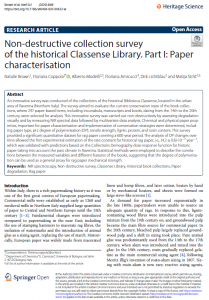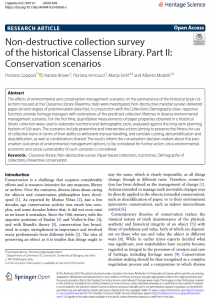For the first time, a medieval rag-paper based collection has been surveyed using the non-destructive analytical instrument developed in the project SurveNIR. The collection of the Classense library in Ravenna is extraordinarily significant, with more than 800,000 items, among which is a collection of works of Dante Alighieri.
Based on the data collected in the survey, the natural rate of degradation of rag paper could be calculated. In addition, it was shown that the mechanical properties of rag paper mostly depend on the degree of polymerisation of cellulose and to a lesser extent on the presence of surface size. These are important pieces of information for conservators and collection managers, as well as heritage scientists.
Importantly, using the Collections Demography damage function for historic paper, the conservation scenarios were calculated for the collection, taking into account its current state of preservation and its rate of degradation in the average summer and winter environmental conditions, climate-controlled conditions as well as hypothetical scenarios that include dehumidification and deacidification (a type of conservation treatment).
It is predicted that if continuously stored in climate-controlled conditions, paper in the most important part of the historical collection will retain sufficient strength for the next 500 years, but that the ink lines in about 50% of the collection may start to break in the next 300 years, leading to potential loss of text. At least 85% of the part of collection stored in non-controlled conditions could be saved by deacidification or storage at a low temperature or low humidity, or both. This data enables collection managers to develop environmental management plans for the collection.
The publications are a result of collaboration between researchers from the University of Bologna and the Classense Library Institution in Ravenna (Italy), as well as the Institute for Sustainable Heritage, University College London (UK), Lichtblau e.K, Dresden (Germany), and the Heritage Science Lab Ljubljana. The survey data has been made openly available for other researchers to explore.


Part I: Paper characterisation Part II: Conservation scenarios
Photo: an example of a degraded ink inscription with text loss (from Part II).

